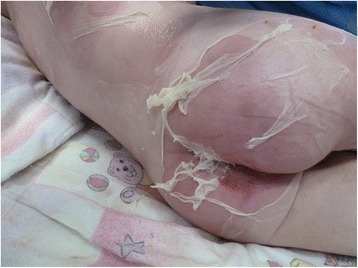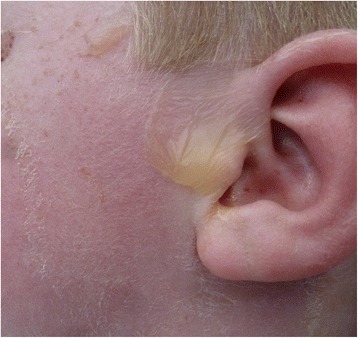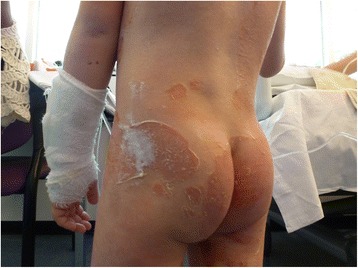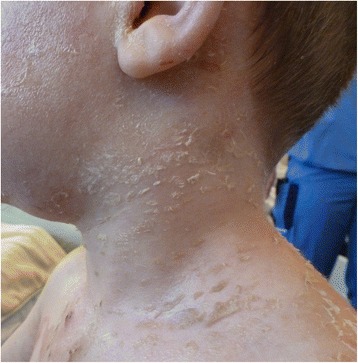Abstract
Background
Staphylococcal scalded skin syndrome is an exfoliating skin disease which primarily affects children. Differential diagnosis includes toxic epidermal necrolysis, staphylococcal scalded skin syndrome, epidermolysis bullosa, and Stevens–Johnson syndrome. Staphylococcal scalded skin syndrome primarily affects children and can cause serious morbidity.
Case presentation
In this case report we highlight the case of a 4-year-old Caucasian boy. Diagnostic and therapeutic challenges are discussed. Differential diagnoses are considered and therapy is described and discussed. The latest treatment options are used and described. Successful results are achieved in this case due to timely and correct management.
Conclusions
Some therapeutic options are widely used without thorough research bases. This case report highlights staphylococcal scalded skin syndrome and its treatment, and future challenges. Further research is warranted and this case report aims to further research in exfoliating skin disorders.
Keywords: Staphylococcal scalded skin syndrome, SSSS, Burn center
Background
Multiple skin conditions present with blistering, such as toxic epidermal necrolysis (TEN), staphylococcal scalded skin syndrome (SSSS), epidermolysis bullosa (EB), Stevens–Johnson syndrome (SJS), and pemphigus. Due to different etiology and treatment, thorough history taking and examination is paramount. Furthermore, morbidity and mortality vary greatly. Therefore, a timely accurate diagnosis is important.
Case presentation
Days 1–4
We present the case of a 4-year-old Caucasian boy with a blistering skin syndrome. He had no relevant medical history and no use of medication prior to this event. No allergies were known and he had been vaccinated, according the Dutch vaccination program.
He presented to an emergency room with a history of loss of appetite, constipation, and agitation of 1-week duration. Furthermore, he experienced pain at his buttocks, lower back, thorax, and face. In addition, skin lesions started in the peribuccal area and appeared after rubbing of the skin (Nikolsky’s sign). At physical examination, erythema and exfoliation were present. He was apyretic. Mucous membranes were not affected. Exfoliation affected 10% of his total body surface area (TBSA). Laboratory tests revealed no signs of infections: leukocyte count (L) of 7.4 × 109 and C-reactive protein (CRP) was 3 mg/l. Further investigation was performed, including skin cultures and biopsies.
Because of superficial scalding, Nikolsky’s sign, and no involvement of mucous membranes, SSSS was considered a working diagnosis and antibiotic treatment was initiated with intravenously administered flucloxacillin and clindamycin. His pain was managed with acetaminophen and morphine intravenously administered. Fluids management was monitored.
Other diagnoses such as TEN and impetigo vulgaris were considered. Since our patient’s mucous membranes were still not affected, SSSS remained most likely. He remained stable and pain was manageable. Figures 1 and 2 indicate exfoliation on day 3.
Fig. 1.

Superficial exfoliation of the lower back and gluteal region on day 3
Fig. 2.

Superficial exfoliation of the face on day 3
Days 4–10
He was transferred to our Burns Unit in Red Cross Hospital in Beverwijk, the Netherlands. Most of the blisters had since resolved. The affected TBSA decreased to 5%. Antibiotic treatment was continued intravenously, and local analgesic therapy was added with Cavilon® (dimethicone) barrier cream. Clindamycin was continued to counter toxin secretion [1]. Feeding was managed via nasogastric tube. Our patient reported pain around his hands and feet. His leukocyte count remained normal: 7.3 × 109/L. His CRP was slightly elevated: 23 mg/l.
During admission, his pain slowly subsided and exfoliation healed after 3 days without scarring. Exfoliation of his hands and feet developed some days after his report of pain but also healed within 3 days. After 5 days the antibiotics were administered orally, to a total of 7 days. Corneal exfoliation at the epidermis indicated superficial blistering. On day 10 he was discharged without complaints. Figures 3 and 4 show advanced healing on day 7.
Fig. 3.

Healed exfoliation of the lower back and gluteal region on day 7
Fig. 4.

Healed exfoliation of the face on day 7
Pathologic results
Extensive subcorneal exfoliation without inflammatory reaction or inflammatory cells, no keratinocytes, and no segmented granulocytes. Findings indicate SSSS.
Cultures
Common skin bacteria.
Discussion
In this case, a prompt diagnosis of SSSS and treatment resulted in rapid healing and timely discharge. No complications or later complaints were reported.
SSSS is a rare skin condition which primarily affects children. It was first described by a German physician, von Rittershain, in 1878 [2], the staphylococcal infection causes superficial skin blisters. Exfoliation of the skin is caused by exfoliative toxins, types A and B (ETA and ETB). These toxins are excreted by the staphylococci and lead to the cleavage (of segmentation) of desmoglein complex 1. Disintegration of the desmosomes anchoring the strata granulosa [3] causes exfoliation. Not all phage types of Staphylococcus produce toxins [4]. The Staphylococcus which initially causes the disease is often not found in the biopsies or cultures, but usually originates from the nasopharynx. The condition causes severe morbidity and mortality if not treated promptly and correctly. In adults, mortality rates as high as 60% have been reported; in children mortality is generally lower, 4% [5].
Complications of SSSS include pneumonia, dehydration, and sepsis, albeit rare. Dehydration can lead to electrolyte imbalances; therefore, fluid management and laboratory monitoring are key. Some clinics include lactulose as a treatment as toxins are excreted gastrointestinally, especially in babies who lack mature kidneys. Prompt diagnosis and treatment halt further exfoliation and prevent morbidity and mortality. Staphylococcus aureus is usually susceptive to flucloxacillin. With the rise of multi-resistant strains such as methicillin-resistant Staphylococcus aureus (MRSA), the initial antibiotic regimen is due to change. In this case we also included clindamycin because this inhibits the toxins which cause the exfoliation.
SSSS can mimic other exfoliating diseases such as TEN and SJS. Differentiation is mainly done by assessing mucosal involvement. Furthermore, a lack of dermal inflammation indicates SSSS as TEN and SJS cause full thickness exfoliation. The diagnosis is often made by exclusion if there is exfoliation in the absence of signs of infiltration [6, 7]. Specific techniques such as polymerase chain reaction (PCR) tests to identify specific toxins are not readily available in most clinical settings [8].
Further studies should be conducted to assess the potential benefit of clindamycin. In addition, studies should be conducted into staphylococcal subtypes, as only a small portion excrete toxins. Knowledge of toxin excretion could have clinical implications. Lack of evidence and possible worsening or initiation of dehydration and electrolyte imbalances were the reasons for us not to include lactulose. Further research is warranted to assess a possible positive effect of standard lactulose treatment, especially in children. This case report highlights the lack of evidence which is needed to formulate evidence-based international guidelines.
Conclusions
This case report highlights SSSS and its challenges in diagnosis and treatment. Therapeutic options and differential diagnosis are discussed. This case report highlights the successful therapy in our patient. Some treatment options are widely used without thorough research bases or guidelines. Further research is warranted and this case report aims to further research in exfoliating skin disorders.
Acknowledgements
Not applicable
Funding
Not applicable
Availability of data and materials
Data sharing not applicable to this article as no datasets were generated or analyzed during the current study.
Authors’ contributions
PJH conceived the case report and drafted the manuscript; AdV participated in its design and coordination and helped to draft the manuscript. Both authors read and approved the final manuscript.
Ethics approval and consent to participate
Ethics approval is not applicable for this case report since this case report does not report on or involve the use of any animal or human data or tissue.
Consent for publication
Written informed consent was obtained from the patient’s legal guardians for publication of this case report and any accompanying images. A copy of the written consent is available for review by the Editor-in-Chief of this journal.
Competing interests
The authors declare that they have no competing interests.
Publisher’s Note
Springer Nature remains neutral with regard to jurisdictional claims in published maps and institutional affiliations.
Contributor Information
P. J. Haasnoot, Phone: 0251 26 55 55, Email: phaasnoot@rkz.nl
A. De Vries, Phone: 0251 26 55 55, Email: adevries@rkz.nl
References
- 1.Gil Sáenz FJ, Herranz Aguirre M, Durán Urdániz G, Zandueta Pascual L, Gimeno Ballester J, Bernaola IE. Clindamycin as adjuvant therapy in staphilococcal skin scalded syndrome. An Sist Sanit Navar. 2014;37(3):449–53. doi: 10.4321/S1137-66272014000300017. [DOI] [PubMed] [Google Scholar]
- 2.von Rittershain G. Die exfoliative Dermatitis jungerer Sauglinge. Zent-Ztg Kinderheilkunde. 1878;2:3–23. [Google Scholar]
- 3.Hanakawa Y, Schechter NM, Lin C, Garza L, Li H, Yamaguchi T, Fudaba Y, Nishifuji K, Sugai M, Amagai M, Stanley JR. Molecular mechanisms of blister formation in bullous impetigo and staphylococcal scalded skin syndrome. J Clin Invest. 2002;110:53–60. doi: 10.1172/JCI0215766. [DOI] [PMC free article] [PubMed] [Google Scholar]
- 4.Ladhani S, Robbie S, Garratt RC, Chapple DS, Joannou CL, Evans RW. Development and Evaluation of Detection Systems for Staphylococcal Exfoliative Toxin A Responsible for Scalded-Skin Syndrome. J Clin Microbiol. 2001;39(6):2050–4. doi: 10.1128/JCM.39.6.2050-2054.2001. [DOI] [PMC free article] [PubMed] [Google Scholar]
- 5.Patel GK, Finlay AY. Staphylococcal scalded skin syndrome: diagnosis and management. Am J Clin Dermatol. 2003;4:165–75. doi: 10.2165/00128071-200304030-00003. [DOI] [PubMed] [Google Scholar]
- 6.Aydin D, Alsbjørn B. Staphylococcal scalded skin syndrome in a 5-year-old child, case report. Clin Case Rep. 2016;4(4):416–9. doi: 10.1002/ccr3.535. [DOI] [PMC free article] [PubMed] [Google Scholar]
- 7.Chi C-Y, Wang S-M, Lin H-C, Liu C-C. A Clinical and Microbiological Comparison of Staphylococcus aureus Toxic Shock and Scalded Skin Syndromes in Children. Clin Infect Dis. 2006;42:181–5. doi: 10.1086/498901. [DOI] [PubMed] [Google Scholar]
- 8.Ladhani S, Joannou CL, Lochrie DP, Evans RW, Poston SM. Clinical, Microbial, and Biochemical Aspects of the Exfoliative Toxins Causing Staphylococcal Scalded-Skin Syndrome. Clin Microbiol Rev. 1999;12(2):224–42. doi: 10.1128/cmr.12.2.224. [DOI] [PMC free article] [PubMed] [Google Scholar]
Associated Data
This section collects any data citations, data availability statements, or supplementary materials included in this article.
Data Availability Statement
Data sharing not applicable to this article as no datasets were generated or analyzed during the current study.


